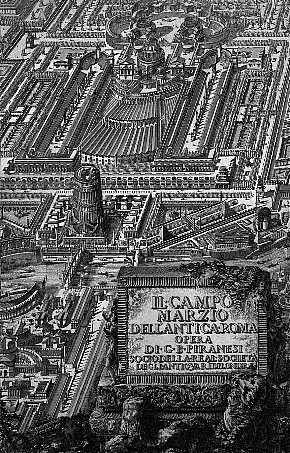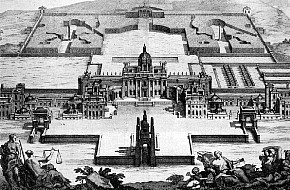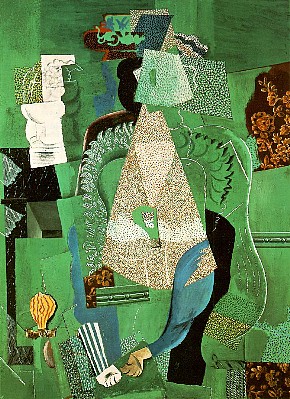1998.02.15
continual mistakes and reversals
After seeing how the figure captions are inverted with regard to the Ichnographia and the Nolli Plan in the Peter Eisenman section of Autonomy and Ideology, it reminded me of the other mistaken inversions that I have found in other texts on the Ichnographia. For example, the east/west and other mistakes (Equirria and Antoninus Pius) of Fasolo, the mis-characterization in the Ichnographia-Jerusalem essay, the mention of inversion in the Allen essay, and my own mistake about the direction of the Triumphal Way. I find these mistakes to be uncanny, as if the Ichnographia had the power to confuse anyone who studied it (and here I can quote Kreiger).
"Rome's Campus Martius suggests an impossible tension among competing parts, perhaps even anarchy. The engraving itself seems to pulsate and change patterns as one studies it."
The strange thing is that Piranesi seems to make the same kind of (archeological) mistakes.
1998.11.16
Tafuri, Manfredo
After an extended independent analysis of the Ichnographia Campus Martius, it becomes evident that Tafuri misreads Piranesi's large plan in most cases. Tafuri's text indicates no research of the plan beyond simply looking at it and subsequently offering a description of what Tafuri thinks he sees. (In fact, a careful reading of both Tafuri's texts and the text of Fasolo from 1956, clearly shows that Fasolo's text greatly influenced Tafuri's observations.) For example, in calling out the various axes of the Campo Marzio, Tafuri notes the axis running through Hadrian's Tomb, but he fails to recognize it's symbolic function as the Axis of Death; nor does he identify the Axis of Life that runs perpendicular to the Axis of Death. Moreover, Tafuri marginally notes the semblance of an axis within the northeast sector of the plan, yet he never mentions that Piranesi labeled this axis the Equiria, place of the annual horse races instituted by Romulus in honor of Mars.
These are just two examples which plainly demonstrate that Piranesi's plan holds significant and coherent symbolic content, however, recognition of Piranesi's "carved in stone" symbolism necessarily negates Tafuri's primary thesis that the Ichnographiam Campi Martii is utterly fragmented and devoid of "language." Ironically, had Tafuri not discounted the presence of language and instead actually translated the hundreds of Latin labels Piranesi applies throughout the plan, he would have concluded with a more accurate, if not also a more honest reading.
It is truly unfortunate that the subsequent 20th century Campo Marzio analyses of Allen, Bloomer, and Eisenman, build upon Tafuri's mistakes rather than correct them.
1998.12.01
on the Campo Marzio:
excerpts from Assemblage (December, 1989):
The Campo Marzio, [Piranesi] notes, had always been dedicated to the training of youth and military exercise; but during the empire it was opened to other uses -- pleasure and spectacle. As more and more buildings were erected for such pursuits, "the Campo no longer appeared to be an appendage of Rome, but, more properly, Rome, the sovereign of all cities, an appendage of the Campo, as Strabone has attested." Piranesi has faithfully mirrored this inversion, and gone even further. In his variant, the city itself is absent, a blank space on the drawing.
This marginal status is consistent historically and is reinforced by an examination of the programmatic legends of the building represented in Piranesi's plan. Buildings of military use are evident, as are those devoted to spectacle and to the culture of the body. But the plan is dominated by the immense figures of two funerary monuments to Hadrian and Augustus. Lying outside of the consecrated ground defined by the city walls, the Campo Marzio had traditionally been the. site of funerals and burials. Thus the urban texture of the Campo Marzio is also characterized by marginality, by otherness. It becomes the locus of all that is excluded from the city proper: the armories and military exercise yards; the stadia and gymnasia; the amphitheaters and circuses; the gardens and pleasure fountains; the crypts and tombs. The conventional institutions of the imperial city are absent. Save in the funerary monuments, there is no civic presence; streets are nonexistent, as is the whole domestic fabric of the city.
If the site plan is the result of an inversion, the city having been folded back upon itself, something analogous happens in Piranesi's representation of time.
(p. 75)
It is this copresence of the scientific (geometrical and archeological) and the ludic that makes Piranesi's project resonant in this century. The same site that authorizes Piranesi "lawless" combinations also authorizes the cross-historical comparisons that would place Piranesi side by side with Duschamp, Man Ray, or Roussel.
(p. 77)
In the Campo Marzio the seamless manner in which the known fragments of the past have been integrated into the whole composition attests to an overriding principle. The internal correspondence of the parts to one another rather than the "truthfulness" of the parts themselves allows these fragments to be inserted at a meaningful point into the larger order of the project. Piranesi has invented a compositional language in order to make sense of the fragment. These fragments disappear into the composition not because their fragmentary nature has been concealed or covered over, but because they have themselves redefined the rules for "fitting in." The whole and the parts submit to the same geometric rules. Piranesi demonstrates that, through the multiplication of the simple, the rationality of geometry, can describe both the indecipherable fragment and the fully realized composition. But the arbitrariness of the combinations suggests that, given those rules, the permutations are endless.
The plan confirms this. The assurance of repeatability contained in the classical principles of regularity is entirely pervaded by contingency. Geometry is understood here for the first time as "instrumental," but this instrumentality undercuts the rational principles that underlie it. The critique of formalism turns back on itself, uncovering the mechanics of an endless chain of combinations that is by itself unable to constrain the combinatory mechanisms. The "useless machines" of the Campo Marzio turn out to be self-perpetuating.
(p. 97)
1999.01.29
eros et thanatos 2683a
| |
Assemblage 10 (Cambridge, MA: The MIT Press, December 1989).
70

G. B. Piranesi, frontispiece to Il Campo Marzio dell' antica Roma, 1762
1Joseph Rykwert, The First Moderns: The Architects of the Eighteenth Century (Cambridge, MA: MIT Press, 1980), Anthony Vidler, The Writing of the Walls (Princeton: Princeton Architectural Press, 1987), or Manfredo Tafuri, The Sphere and the Labyrinth: Avant-Gardes and Architecture from Piranesi to the 1970s, trans. Pellegrino d'Acierno and Robert Connolly (Cambridge, MA: MIT Press, 1987), are only the most obvious examples, to which might easily be added the writings of George Teyssot. Foucault, especially the Foucault of The Order of Things, would seem to be behind much of this work. Tafuri's chapter on Piranesi in The Sphere and the Labyrinth, "'The Wicker Architect': G. B. Piranesi, Heterotopia, and the Voyage," as well as the passages in his Architecture and Utopia: Design and Capitalist Development, trans. Barbara Luiga La Penta (Cambridge, MA: MIT Press, 1976), has been fundamental in the formulation of my approach to this project.
2Rykwert, The First Moderns, 370.
3The phrase is Rykwert's, ibid.
4Tafuri, Architecture and Utopia, 15.
5Alain Robbe-Grillet, "From Realism to Reality" (1955), in For a New Novel: Essays on Fiction, trans. Richard Howard (New York: Grove Press, 1965), 165.
| |
Stanley Allen
Piranesi's Campo Marzio: An Experimental Design
71
The archeological mask of Piranesi's Campo Marzio fools no one: this is an experimental design and the city, therefore, remains an unknown.
Manfredo Tafuri, Architecture and Utopia, 1973.
What is the nature of an experimental action? Is it simply an action the outcome of which is not foreseen?
John Cage, "History of Experimental Music in the United States," 1958.
To locate precisely the beginnings of modernity has been a preoccupation of recent critical and historical work.1 The work presented here seeks to suspend this "search for origins," proposing instead to enter into the classical at a strategic moment: a seam opened by Piranesi's "necrophiliac passion for the glory of ancient Rome."2 What is uncovered in the decay of the classical is not only a latent modernity (which could be a parasite upon this disintegrating body), but also the instability of the classical itself. Within Piranesi's project, the "naturalness" of the language of classical architecture (already called into question a century before) is destroyed by a contamination and fragmentation completely at odds with historically developed ideas of the wholeness of language.
By directing architecture's gaze back upon itself with this "morbid precision," by demonstrating the futility of a return to origins, Piranesi establishes in the Campo Marzio a plane--a shifting, indeterminant plane--upon which the horizons of classicism and the most radical project of modernity momentarily coincide.3 It is for this reason that
72
twentieth-century readings of Piranesi have underlined a dissonance and disjunction existing alongside the classical: Sergei Eisenstein has called this explosion of concrete relations in space an "ecstatic transfiguration"; Manfredo Tafuri has referred to the application of the "technique of shock" to the foundations of rationality. Duchamp, Picabia, Kafka, and Roussel have all echoed the spirit of Piranesi of which, Tafuri writes, "the obsessive reiteration of the inventions reduces the whole organism to a sort of gigantic 'useless machine.'"4
This project intends an excavation--through drawing and writing--of the "negative utopia" drawn by Piranesi for the Campo Marzio of Rome. I have conceived of Piranesi's large plan (the granda pianta as a site to be colonized, covered over, and modified, as when a building is erected on ruins. My attempt is to uncover and articulate the surplus residue of meaning that confirms the inexhaustibility of a work of architecture. This process of rereading establishes a relationship parallel to that which Piranesi maintained toward his own (archaeological) sources: dreamlike, inventive, and improvisational.
Given this inexhaustibility, the evident surplus meaning, I would suggest that the only way to confront adequately the project of Piranesi is with another project. I have maintained a strict parallelism of drawings and text. The drawings are independent of specific references to the text but must be read together with it. Analytical drawings map out the relation of the Piranesi reconstruction to existing ruins and the context--real and fictional--of eighteenth-century Rome. Projections and constructions suggest new ways of reading the notations of Piranesi's project. The text follows an absolutely normative pattern: site, context, program. Each of these three terms, however, is reread in light of Piranesi's own intentions, and the doubling of the middle term "text-context" intends to disrupt the stability of the three part structure.
As this project has acquired shape and certainty, I have not sought an elaboration of meaning, but rather, a greater precision of detail and description, remembering, as Robbe-Grillet said of Kafka, that "even what the hero is searching for vanishes before the obstinacy of his pursuit, his trajectories, his movements; they alone are made apparent, they alone are made real.5
| |
Quondam
An Experiment
2013.12.23 19:47

I'm now wondering whether the above image of Castle Howard from Vitruvius Britannicus (published 1715-1725) somehow inspired the architecture of Piranesi as delineated within Il Campo Marzio (1762). Remember the...
I was prompted by the "what is experimental architecture" thread to look again at "Piranesi's Campo Marzio: An Experimental Design." After reading a few pages it became evident that the essay/project could be 'rewritten' to deliver a whole other set of results, a whole other 'history.'
By covertly publishing the Ichnographia in a second state was Piranesi himself conducting an experiment to see who would ultimately discover the two different plans?
Piranesi's language of the plans relates back to the origins of Rom(ulus and Remus) itself.
"Both Piranesi's Campo Marzio and Picasso's Dame au violon are "projects," though the former organizes an architectural dimension and the latter a human mode of behavior. Both use the technique of shock, even if Piranesi's etching adopts preformed historical material and Picasso's painting artificial material (just as later Duchamp, Hausmann and Schwitter were to do even more pointedly). Both discover the reality of a machine-universe: even if the eighteenth century urban project renders that universe as an abstraction and reacts to the discovery with terror, and the Picasso painting is conceived completely within this reality.
But more importantly, both Piranesi and Picasso, by means of the excess of truth acquired through their intensely critical formal elaborations, make "universal" a reality which could otherwise be considered completely particular."
Manfredo Tafuri, Architecture and Utopia: Design and Capitalist Development, p. 90.
There is no Picasso painting with the title Dame au violon, but it is possible that Tafuri is referring to Portrait of a Girl (1914):

Project: redraw the Ichnographia Campus Martius following the principles of Picasso's (Synthetic) Cubism.
|